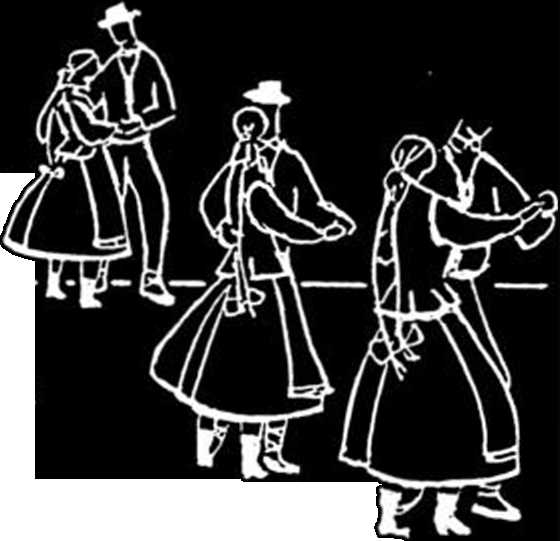6585844835
The Powolnlak Turnlng Step - one fuli CW turn takes 1^/2 raeas. Step Ib done on slightly bent knees. M: etep R ft fwd through the heel, start-Ing a CW turn (ct 1 of lst meae); step L ft bkwd, continulng the CW turn (ct 2 of lst meas); place toes of your R ft on the floor behlnd your L heel and complete the turn (ct 1 of 2nd raeas).
Repeat of step ls done on ct 2 of 2nd meas and cts 1,2 of 3rd meas. W: do the step ldentically to the M, except start the seąuence by stepping L ft bkwd (ct 1 of lst raeas), then placing toes of your R ft behlnd your L heel (ct 2 of lst meas), etc. (Notę: the cue ls M: R - L - touch R,
W: L - touch R - R, see diagram on last page of the Powolnlak.)
Formatlon: Cpls around the roora in open shldr-walst pos, both facing
LOD and slightly t rd ptr; M ls slightly leaning twd ptr and his free (L) hand ls ln a flst, placed on the fwd part of his own hip, elbow slightly fwd; with her free (R) hand W hold6 her skirt, spreading it out to the slde. (Notę; ptrs raay also Join the outside hands at waist level, elbows slightly bent.)

Measures PATTERN
INTRODUCTION 1-4 No actlon.
I. PREPARATION (Hel A - 6 meas playea twice)
1-11 Beg M-L, W-R, móve smoothly in LOD with 11 smali, 8liding, fiat two-steps.
12 With 2 accented steps (M-RL, W-LR) ptrs
face each other and a6sume closed soclal dance pos, stralght arras Jolned and extended to sides.
^ Yarlatlons to Fig I
Done ln jglace - be careful not to be in the way of the moving cpls:
1. WitE wt on inside ft, both knees bent, do a wtless stamp with outside ft on ct 1 of each meas.
2. Beg outside ft, with bent and springy knees do 2 steps per meas.
Done_moving _ln_LODj.
3. Beg with outside ft,. raove in LOD with 2 smali steps per raeas, done on bent and springy knees, barely lifting the soles of your ft off the floor.
4. For M only: still in original pos move in LOD with 11 smali
8lldlng step-together1 s, with L ft facing ln LOD and accentinrr with it on each ct.
12 In all 4 varlatlons, with 3 steps (cts 1,&, 2, M-LRL, W-RLR) or
with 1 step-hold (ct 1-2, M-L, W-R) get into the pos of raeas 12 (Fig I).
Notę: ptrs do not have to move with the same step-variation; for
instance, M can use the polka step (meas 1-11, Fig I), while
W uses the walking step (nr. 3), or M can use the sllding step
(nr. 4), while W uses the polka step.
Wyszukiwarka
Podobne podstrony:
cattlemutilators Cattle Mutilators The UFOs may draw one extra card per turn if they conCrol this gr
Topcom Remote!7095 Programming the DSS® Remote t Step 4 Enter one of the three-digit codes listed fo
Step 1. Pick OTUs with the fast method using your fuli input seguence collection. plck_otus.py -■ pr
14740 vampires Vampires The Assassins may drauu one extra card per turn if they control thia group.
computerdatingservices Computer Dating Services The NetWork may draw one extra card per turn if it C
image002 Brian Aldiss is one the most influential -and one of the best - SF writers Britain has eve
img1223 1 DIAGRAM ONE Three Constellations, The Earth. One of the stars of the Grc*2t.Bcar, One of t
Shadowing losses: These losses occurred due to the physical obstacles. (like one building) It is als
Zamki Na Lodzie. PDF eBooks Download contraband anyway? Finally, if they d just opened the bottles a
P1130005 Fig. 1.24: Intense echogenicily (arrows) at the site of the est-rous follicle one day after
m231D Inside the upper story of one of the towers of the Chateau de Val. These cramped spa
MR293R190 4 1 RENOYAŁ Adjustlng the striker piąte. Remove the two screws (1) and puli the lock, turn
netter61 Cardiac CycleCARDIOVASCULAR PHYSIOLOGY Figurę 4.9 Cardiac Cycle The cardiac cycle represent
więcej podobnych podstron